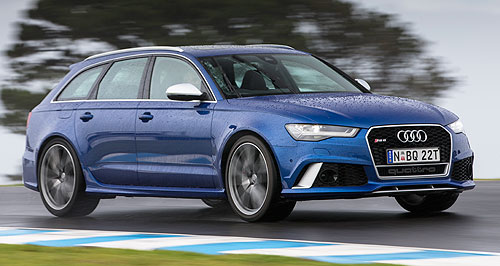New models - Audi - A6 - RS6 and RS7Driven: Audi’s powerful pair updated for 2015Bang and bucks: Both the RS6 and RS7 make more power than Audi’s range-topping R8 V10 Plus. RS6/RS7 complete A6/A7 update cycle, remain as highest-powered duo in Audi roster14 May 2015 By TIM ROBSON AUDI has completed its A6 and A7 range update with the Australian launch if its big-brawling RS6 Avant and RS7 Sportback eight months after their European debut. Both the RS6 Avant and RS7 Sportback pack a mighty wallop, making 412kW and 700Nm from a 4.0-litre twin turbo V8, racing from 0-100km/h in just 3.9 seconds and capable of a 280km/h top speed. The cars are the most powerful that Audi currently produces. Its R8 V10 Plus is the next-best performer, making 404kW from its naturally aspirated V10. Minor changes have been implemented for the model year 2015 iterations, in line with the recent local refresh of Audi’s resurgent A6/A7 duo. Audi Australia managing director Andrew Doyle highlighted the performance capabilities and practicality of the company's powerful twins. “These new models combine innovation, functional design and phenomenal performance into two distinctive vehicles that reflect the very best of what the Audi Sport team is capable of,” he said. “Owners of these vehicles can experience the passion that has driven the team to record-breaking motorsport success, every single day.” Both the RS6 Avant wagon’s price-tag of $229,500 and the four-door coupe RS7’s ticket of $242,000 remain unchanged. Both prices are before on-road costs. The duo has combined to sell 110 cars for Audi Australia since their respective launches. The RS6’s longer on-sale period has given it 60 sales, while the RS7 has chipped in 40. Revised front grilles, a new headlight design, revised side skirts, updated rear-end styling and a refreshed interior layout are supplemented by minor equipment upgrades. Audi’s Matrix LED headlight units are standard fitment on both cars, while dynamic turn signals are also fitted front and rear. A new screen in the RS-specific instrument binnacle supplements an updated infotainment system, while a pair of USB ports nestle in the centre console. One of the USB ports can detect when a phone is connected, doubling its output to charge the phone more quickly. The new MIB2 infotainment system also has the ability to read and analyse geo-tagged images load up suitably geo-tagged images from a phone or camera to the car via USB, and the satellite navigation system can automatically set up a route to the pictured destination. It also offers a 4G-capable wifi hotspot function. If you need a little more oomph to your music, a Bang & Olufsen 15-speaker, 1200watt stereo can be optioned for an additional $12,000. The relatively minor changes to the RS6 and RS7 complement a very long list of standard inclusions, including adaptive air suspension, digital TV, electronic rear differential, two-mode RS sports exhaust, head-up display (HUD) 21-inch alloy wheels, front and rear parking cameras and a sunroof. The duo features a version of Audi’s multi-mode Drive Select suite that allows the driver to pick from Comfort, Standard, Dynamic and Individual modes. The system changes throttle and gearshift maps, exhaust note and steering feel, as well as the suspension tune on the standard car. As part of a $4900 Dynamic Package, Audi will replace the air suspension with steel springs and three-way adjustable dampers that are all connected via diagonally-opposed fluid lines. It will also recalibrate the electro-mechanical steering and increase the standard 250km/h speed limiter to 280km/h. If the stock brake package of 390mm front rotors with six-piston callipers doesn’t suit, there is a ceramic rotor option that increases the front brake size to a huge 420mm in diameter. The ceramic brakes can be built into a Dynamic Plus package, which incorporates all the elements of the Dynamic package, as well as a further tweak of the top speed limiter to 305km/h, for $25,840, or purchased separately for $20,940. A retune of the 4.0-litre twin-turbo V8 direct-injection petrol engine – which also nestles under the bonnet of the Bentley Continental GT and in a detuned state in the S6/S7 – has netted a tiny fuel save gain for both variants. The sleek RS7 Sportback returns 9.5 litres per 100 kilometres, while the more bluff RS6 wagon returns 9.6L/100km an improvement of 0.2L/100km on both cars. The V8 is fitted with cylinder deactivation technology that shuts down one engine bank on light throttle loads. The fettled-for-RS seven-speed transmission remains the same, with its shorter first four gears and taller eighth cog, though a shift light feature has been incorporated. Its 60/40-rear/front drive distribution Haldex AWD system, complete with an electronically controlled rear diff, also carries over from the pre-facelift cars.  Quick testsRead more10th of December 2014  Audi to accelerate RS modelsSales soar as Audi commits to bringing in S and RS performance models earlierAll new models Alfa Romeo Alfa Romeo Abarth Abarth Audi Audi Aston Martin Aston Martin BMW BMW Bentley Bentley Chrysler Chrysler Chevrolet Chevrolet Dodge Dodge Citroen Citroen Ferrari Ferrari DS DS Ford Ford Fiat Fiat FPV FPV Foton Foton Haval Haval Great Wall Great Wall Honda Honda Holden Holden Hyundai Hyundai HSV HSV Isuzu Isuzu Infiniti Infiniti Jeep Jeep Jaguar Jaguar Lamborghini Lamborghini Kia Kia Lexus Lexus Land Rover Land Rover Mazda Mazda Maserati Maserati Mercedes-Benz Mercedes-Benz McLaren McLaren Mini Mini Nissan Nissan Mitsubishi Mitsubishi Peugeot Peugeot Opel Opel Proton Proton Porsche Porsche Renault Renault Ram Ram Saab Saab Rolls-Royce Rolls-Royce Smart Smart Skoda Skoda Subaru Subaru SsangYong SsangYong Tesla Tesla Suzuki Suzuki Toyota Toyota Volvo VolvoA6 pricing
Motor industry news |
|







































Facebook Twitter Instagram